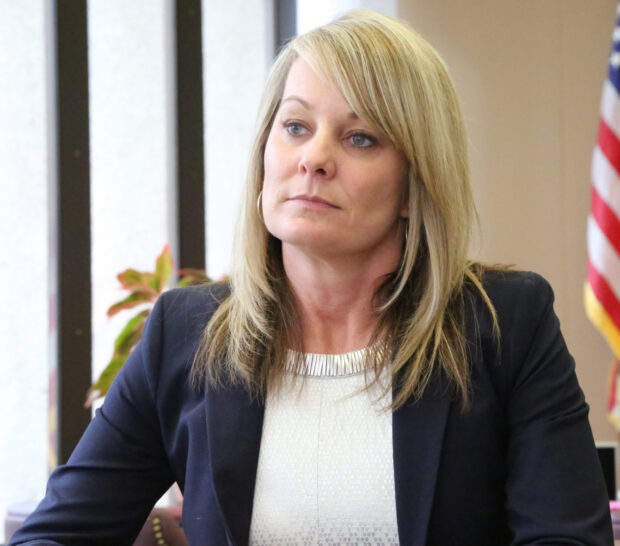Idaho’s investment of $135 million in a math initiative and training for teachers has failed to move the needle when it comes to student achievement in mathematics.
And when the investment began in 2008, lawmakers were promised positive results. Instead, scores have gone down, according to an Idaho Education News analysis of math scores and student achievement.
The percentage of eighth-graders scoring at or above grade-level benchmarks on the math section of the National Assessment of Educational Progress dropped from 38 percent to 34 percent over the seven-year period. For fourth-graders, math proficiency levels dropped from 41 percent of students to 38 percent over that same time period.
Those sobering results — along with multiple other indicators of student math achievement — have sent shockwaves through the highest levels of state government and among key decision-makers.

“Our math scores are stagnant and we need to do something about it,” Superintendent of Public Instruction Sherri Ybarra said during last week’s State Board of Education meeting.
Measuring student achievement in mathematics or any subject is a complex affair, and NAEP scores are just one indicator.
Over the time period analyzed for this article, Idaho lawmakers adopted new academic standards in mathematics and switched to a new assessment test. During the 2014-15 school year, Idaho students took the Idaho Standards Achievement Test by Smarter Balanced (the so-called SBAC tests) for the first time. To date, only one year’s worth of SBAC testing data has been released to the public. The 2015-16 scores are scheduled to be released in September.
But those first-year SBAC scores were also a concern even though state education officials repeatedly warned parents and school leaders to expect lower scores as students adjusted to a totally new method of testing and the new Idaho Core standards in math.
According to final SBAC data released by the state, just 30 percent of Idaho high school students earned grade-level scores of “proficient” or better in 2014-15. For eighth-graders, the level of SBAC proficiency was 37 percent.
On this year’s SAT test, Idaho high school students earned an average score of 490 out of a possible score of 800, with only 35 percent of students hitting college-readiness benchmarks. The average score of 490 was below the score of 530 that the test’s developers say is an indicator that students are likely to earn at least a “C” average in college. Idaho’s score of 490 did beat the national average of 486.
“It pretty clear math is something we need to focus on,” State Department of Education spokesman Jeff Church said this week. “But this isn’t only an Idaho issue — it’s a national issue.”
What Idaho spent — and what it bought
In 2008, previous schools chief Tom Luna asked the Legislature for — and received — $3.9 million to help implement a new statewide math initiative. According to a State Department of Education 2008 legislative report, the math initiative was needed because students didn’t have the real-world math skills necessary for the workplace. Within that same report, officials expressed concern that levels of math proficiency dropped as students got older and progressed in school.
Finally, the legislative report stated that the initiative “will help raise student achievement in mathematics across all K-12 grades” by focusing on teacher education, student achievement and public education.
One of the most high-profile programs education leaders spent the increased funding on was a 45-hour Mathematical Thinking Initiative course for most teachers and school administrators.
“There were a couple of components to that (course), but the main one was to provide training for in-service teachers to go back and retrofit their knowledge of math and focus on a deep, conceptual knowledge of math — not just memorizing formulas and having the kids do shortcuts,” said Scott Cook, the State Department of Education’s director of academic services, support and professional development.

Jonathan Brendefur, a Boise State University professor who served as a director of the state’s MTI program, has written that there was a huge need for “high-quality, professional development training that gives teachers the knowledge and pedagogical tools to teach for deep mathematical understanding.”
Brendefur said the state’s MTI course succeeded in providing some of that training and increasing teachers’ knowledge and understanding of math.
“In the first five years, we got 12,000 teachers and administrators through the course, which is pretty impressive,” Brendefur said.
State officials also invested some of that influx of funding in an online supplemental math program that has been known as Apangea and Think Through Math.
But after seven years, a nearly $16.5 million investment in the math initiative and another $118.6 million in professional development training for teachers (which districts could apply in many subject areas and types of training, not just math) evidence has not materialized to show the effort was able to “raise student achievement in mathematics across all K-12 grades” as legislators and the public were told in the 2008 legislative report.
Brendefur said he isn’t surprised student achievement didn’t increase. He said the MTI course for teachers and administrators amounted to step one in a multi-step plan that wasn’t executed. He said he warned state officials 10 years ago that the program wouldn’t work if it ended the moment teachers graduated from the math course. To work, experts needed to provide vigorous follow-up training with all 12,000 teachers and administrators at their own school, over a sustained period of time, to help them model instructional techniques.
“If nobody is there to help them, (teachers) just go back to how they were teaching before,” Brendefur said. “The only way to change achievement is if you change instruction.”
When Brendefur told state officials that, “they said ‘we’d like that, but we don’t have the money and time for it,’” he said.
Looking to the future
Ybarra’s administration is pivoting on its approach to math. During the upcoming 2017 legislative session, Ybarra will pitch lawmakers on tying the math initiative to her proposed rural schools center — an initiative that failed to find support during the final days of the 2016 session.
Next year, Ybarra will make the case it is necessary to embed math coaches in regional schools centers to provide ongoing support and instructional modeling for teachers who have already completed the MTI certification course. The program would be based on a similar initiative featuring English language arts coaches that are already in place in Idaho.
Cook and Church said the combination of rural schools centers and the new math coaches would create that valuable follow-up piece that Brendefur said was missing over the previous seven years.
“The vision moving forward is to boil that down and focus on what works,” Church said. “What is working is the coaching.”
Church declined to say how much money Ybarra will request for the regional schools center or how many math coaches will be necessary for the program to succeed.
Last session, Ybarra asked for $300,000 to pilot a single rural schools center in Coeur d’Alene, but the joint budget committee never provided the funding.
Ybarra also said last year that she does not envision launching a rural schools center in the southwest region, which includes smaller districts such as New Plymouth, Horseshoe Bend and Marsing alongside the larger districts of Boise and West Ada.
When asked how he would create a statewide math solution if there were no obstacles in his way, Brendefur said it would require a major cultural shift and significant resources. He suggested places to start would be cutting some spending on curriculum materials and investing that savings in additional professional development.
He envisions a school environment where teachers are collaborating with each other and educational experts or coaches are modeling instruction and observing educators regularly.
“I really want kids to leave high school with a deep understanding of mathematics and the ability to apply it in multiple, real-world scenarios,” Brendefur said. “Right now, I feel like kids are leaving and I don’t feel like they understand mathematics deeply enough to apply it to real-life situations.”
Idaho Education News Data Analyst Randy Schrader gathered data for this article.
Disclosure: Idaho Education News is housed at Boise State University and EdNews reporters are university employees.
